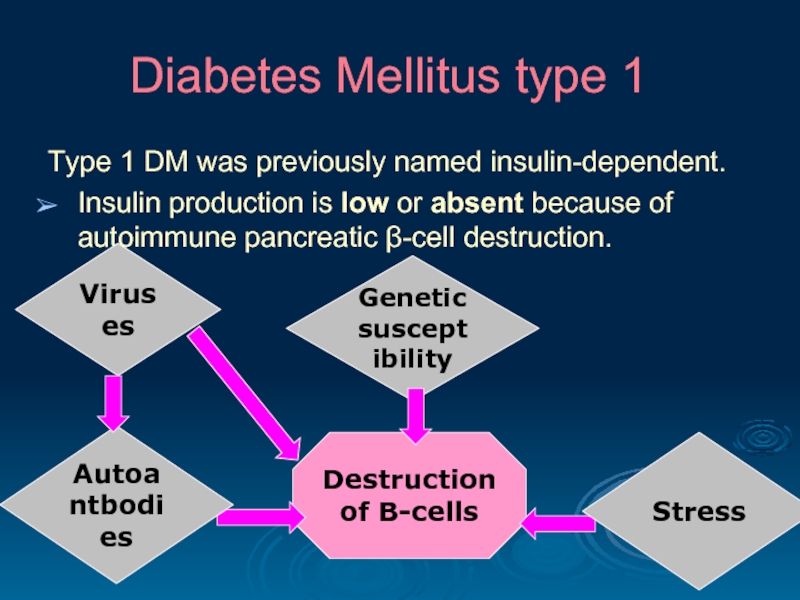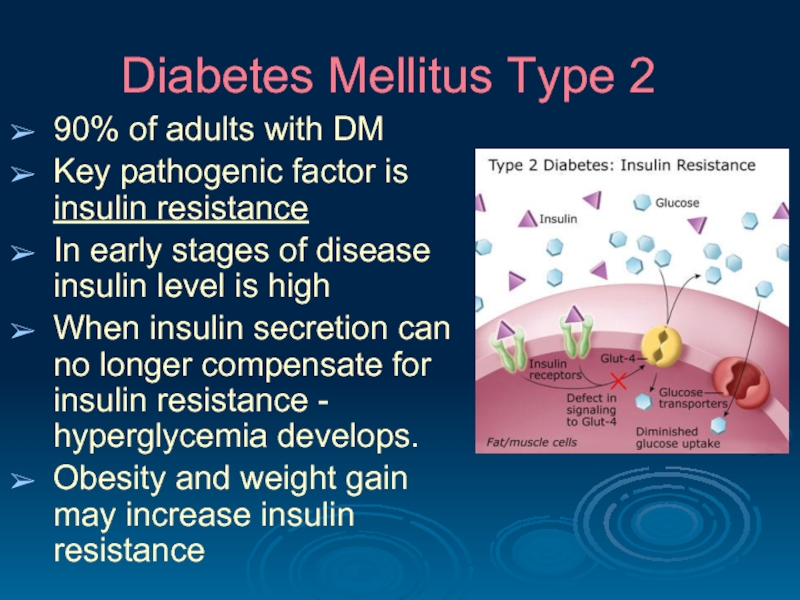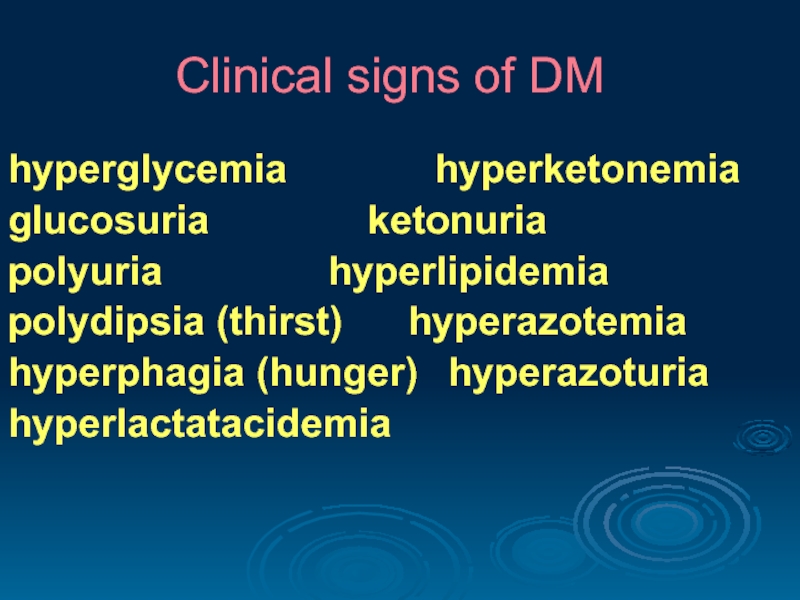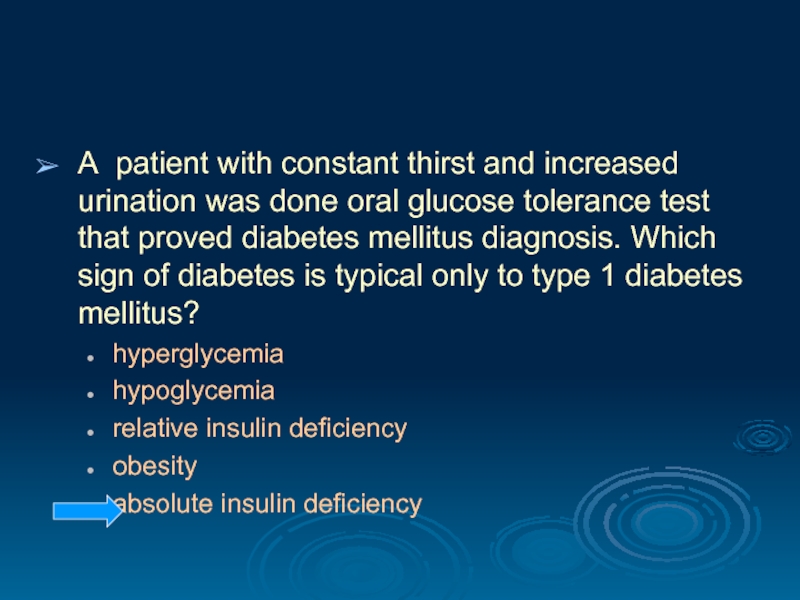- Главная
- Разное
- Дизайн
- Бизнес и предпринимательство
- Аналитика
- Образование
- Развлечения
- Красота и здоровье
- Финансы
- Государство
- Путешествия
- Спорт
- Недвижимость
- Армия
- Графика
- Культурология
- Еда и кулинария
- Лингвистика
- Английский язык
- Астрономия
- Алгебра
- Биология
- География
- Детские презентации
- Информатика
- История
- Литература
- Маркетинг
- Математика
- Медицина
- Менеджмент
- Музыка
- МХК
- Немецкий язык
- ОБЖ
- Обществознание
- Окружающий мир
- Педагогика
- Русский язык
- Технология
- Физика
- Философия
- Химия
- Шаблоны, картинки для презентаций
- Экология
- Экономика
- Юриспруденция
Diabetes mellitus. (Subject 8) презентация
Содержание
- 1. Diabetes mellitus. (Subject 8)
- 2. General information First reports – ancient times
- 3. DM statistics (IDF) 382 millions diabetic patients
- 4. Insulin effects Carbohydrate Metabolism Insulin dependent
- 5. Insulin effects Carbohydrate Metabolism Increases glycogen
- 6. Insulin effects Lipid metabolism ↑ synthesis
- 7. Biological effects of insulin Very fast effect
- 8. DIABETES - is a complex
- 9. The types of diabetes mellitus
- 10. The types of diabetes mellitus
- 11. Diabetes Mellitus type 1 Type 1 DM
- 12. Diabetes Mellitus Type 1 Pathogenesis NORMAL ISLET DIABETIC ISLET
- 13. Diabetes Mellitus Type 2 90% of adults
- 14. DM pathogenesis Hyperglycemia Low insulin
- 15. DM pathogenesis decrease of glucose consumption
- 16. DM pathogenesis Disturbance of protein metabolism
- 17. DM pathogenesis Disturbance of
- 18. DM pathogenesis Absence of insulin or
- 19. DM pathogenesis Accumulation of lactic acid
- 20. DM pathogenesis Accumulation of lactic acid
- 21. Diagnosis of Diabetes Mellitus Fasting Blood Glucose
- 22. Diagnosis of Diabetes Mellitus Glycated Hemoglobin Testing
- 23. Clinical signs of DM hyperglycemia
- 24. Clinical signs
- 25. Choose the characteristic feature of type
- 26. A patient with constant thirst and
- 27. One of the diabetes mellitus clinical
- 28. Patient with diabetes mellitus has hyperglycemia
- 29. Acute complications of DM Diabetic comas hyperglycemic hypoglycemic hyperosmolar hyperlactatacidemic
- 30. Acute complications of DM Hyperglycemic coma
- 31. Acute complications of DM Hypoglycemic coma may
- 32. Acute complications of DM Hyperosmolar coma high
- 33. Chronic complications of DM Microvascular disturbances Diabetic
- 34. Chronic complications of DM Macrovascular disease Coronary
- 35. Chronic complications of DM Diabetic cardiomyopathy results
- 36. Principles of treatment Control of hyperglycemia.
- 37. Prevention of DM Early type 1 DM
- 38. Which coma often occurs in the
- 39. Patient R., 46 years old, has
- 40. A patient was delivered to the
Слайд 2General information
First reports – ancient times
‘diabetes’ – excessive urination
‘mellitus’ –honey.
1922 – insulin discovery
Severe complications
The greatest number of diabetic patients are between 40 and 59 years of age
The most common endocrine disorder
Слайд 3DM statistics (IDF)
382 millions diabetic patients worldwide (8,3%)
46% undiagnosed (in Sub-Saharan
80% patients in low- and middle income countries
India – 65,1millions of patients (8.5%) -2nd position in the world
Nigeria – 3,9 millions (5%)
Ukraine – 1 million (3%)
Слайд 4Insulin effects
Carbohydrate Metabolism
Insulin dependent tissues– muscles, adipose tissue, liver -
Insulin non-dependent tissues - nervous tissue, kidneys, endothelium cells, cells of intestines, beta-cells of pancreas – free glucose uptake
Слайд 5Insulin effects
Carbohydrate Metabolism
Increases glycogen synthesis in the liver.
↓ blood glucose
In the absence of insulin, insulin-dependent tissues switch to alternative sources of energy (fatty acids).
Слайд 6Insulin effects
Lipid metabolism
↑ synthesis of fatty acids in the liver.
↓
↑ synthesis of glycerol in adipocytes →
synthesis of triglycerides → fats storage
Protein metabolism
↑ proteins synthesis and ↓ proteolysis
Слайд 7Biological effects of insulin
Very fast effect – ↑ glucose and ions
Fast effects - ↑ glycogen, fat acids, glycerol and protein synthesis.
Slow effects - ↑ enzymes synthesis that regulate anabolic processes; ↓ catabolic enzymes.
Very slow effects - ↑ cells division.
Слайд 8
DIABETES -
is a complex metabolic disorder resulting from
absolute or
insulin deficiency
Слайд 11Diabetes Mellitus type 1
Type 1 DM was previously named insulin-dependent.
Insulin production
Destruction
of B-cells
Genetic
susceptibility
Viruses
Autoantbodies
Stress
Слайд 13Diabetes Mellitus Type 2
90% of adults with DM
Key pathogenic factor
In early stages of disease insulin level is high
When insulin secretion can no longer compensate for insulin resistance - hyperglycemia develops.
Obesity and weight gain may increase insulin resistance
Слайд 14
DM pathogenesis
Hyperglycemia
Low insulin
Insulin resistance
decrease of glucose
consumption by
muscles and
Starvation
of tissues
Hyperphagia
Слайд 15DM pathogenesis
decrease of glucose
consumption by
muscles and adipose tissue
Disturbance
of energy
metabolism
Activation
of anaerobic
oxidation
Accumulation
of lactic acid
Activation
of gluconeogesis
Liver
Hyperglycemia
Слайд 16
DM pathogenesis
Disturbance of protein metabolism
Protein-rich food
Inability
to uptake
aminoacids
Absence of insulin
or insulin-resistance
↑ blood level
of aminoacids
Glucagon secretion
Activation
of glycogen
disintegration
in the liver
Hyperglycemia
Слайд 17
DM pathogenesis
Disturbance of lipid metabolism
Fatty food
Inability
of fatty acids
uptake
Absence of
or insulin-resistance
↑ blood level
of fatty acids
and triglycerides
Increased
lipolysis
Слайд 18DM pathogenesis
Absence of insulin
or insulin-resistance
Activation
of gluconeogenesis
from aminoacids
Activation
of gluconeogenesis
from
↑ ammonia
and urea in blood
Accumulation
of lipids and
ketonic bodies
in blood
LIVER CELLS
Слайд 19DM pathogenesis
Accumulation
of lactic acid
High blood level
of aminoacids
Increased ammonia
and urea in blood
Accumulation
of ketonic bodies
Hyperglycemia
Dehydration
of tissues
Increase of blood
osmotic pressure
Слайд 20DM pathogenesis
Accumulation
of lactic acid
High blood level
of aminoacids
Increased ammonia
and urea in blood
Accumulation
of ketonic bodies
Hyperglycemia
Polyuria
due to high
osmotic pressure
of urine
glucosuria
ketonuria
lactaciduria
aminoaciduria
hypernitrogenuria
Urine
Слайд 21Diagnosis of Diabetes Mellitus
Fasting Blood Glucose Test.
≤ 6,1 mmol/L -
6,1 mmol/L - 6,9 mmol/L - impaired
≥ 7,0 mmol/L on two occasions = diabetes
Casual Blood Glucose Test.
If ≥11,0 mmol/L + classic symptoms= diabetes
Glucose Tolerance Test (oral intake 75 g of concentrated glucose solution)
Normally blood glucose levels return to normal within 2 to 3 hours after ingestion of a glucose load.
Слайд 22Diagnosis of Diabetes Mellitus
Glycated Hemoglobin Testing (hemoglobin A1C) provides an index
Hemoglobin normally doesn’t contain glucose
If blood glucose level is high the level of A1C is ↑
Glycosylation is essentially irreversible
Urine Tests
Presence of glucose
Presence of ketone bodies
Слайд 23Clinical signs of DM
hyperglycemia hyperketonemia
glucosuria ketonuria
polyuria hyperlipidemia
polydipsia
hyperphagia (hunger) hyperazoturia
hyperlactatacidemia
Слайд 24
Clinical signs of DM
Absence of insulin
Prevalence
of catabolic processes
Excessive hunger
(hyperphagia)
Usage of proteins
and lipids for energy
Patient’s
weight loss
Inability of glucose
uptake by insulin
-dependent tissues
Слайд 25
Choose the characteristic feature of type 1 diabetes mellitus
Middle age at
Associated obesity
Low plasma levels of endogenous insulin
Insulin resistance
Presence of antibodies to islet cells
Слайд 26
A patient with constant thirst and increased urination was done oral
hyperglycemia
hypoglycemia
relative insulin deficiency
obesity
absolute insulin deficiency
Слайд 27
One of the diabetes mellitus clinical symptoms is hyperphagia. It is
lack of energy in the organism
lack of fatty acids in the blood
lack of insulin
excess of glucose in the blood
affection of appetite controlling centers
Слайд 28
Patient with diabetes mellitus has hyperglycemia 19 mmol/ l, which is
low osmotic pressure of blood plasma
lack of insulin
tissues dehydration
glucosuria
hyperglycemia
Слайд 29Acute complications of DM
Diabetic comas
hyperglycemic
hypoglycemic
hyperosmolar
hyperlactatacidemic
Слайд 30Acute complications of DM
Hyperglycemic coma
expressed hyperglycemia (>20 mmol/l);
progressive dehydration
ketoacidosis (metabolic acidosis) with a typical acetone smell from the breath;
increased blood level of catecholamines and glucocorticoids;
inhibition of CNS activity;
Kussmaul’s respiration;
decreased arterial pressure;
tachycardia accompanied by extrasystolia.
Слайд 31Acute complications of DM
Hypoglycemic coma may develop if the glucose intake
The patient become agitated, sweaty, activation of sympathetic nervous system
Consciousness can be altered.
Treatment: sweet drinks /food; in severe cases, an injection of glucagon or an intravenous infusion of glucoset.
Слайд 32Acute complications of DM
Hyperosmolar coma high concentration of glucose, Na, Cl,
the disturbance of consciousness;
the absence of acetone smell from the mouth;
frequent superficial breath, short breath;
tachycardia and heart rate disturbances.
Hyperlactatacidemic coma - rare complication of DM
is observed in elderly people suffering severe accompanying diseases.
Слайд 33Chronic complications of DM
Microvascular disturbances
Diabetic retinopathy - severe vision loss or
Diabetic neuropathy – usually in stocking distribution starting at the feet but potentially in other nerves.
When combined with damaged blood vessels this can lead to diabetic foot .
Diabetic nephropathy - renal failure.
Слайд 34Chronic complications of DM
Macrovascular disease
Coronary artery disease, leading to myocardial infarction
Stroke (mainly ischemic type)
Peripheral vascular disease, which contributes to diabetic foot;
Diabetic foot may cause necrosis, infection and gangrene.
Слайд 35Chronic complications of DM
Diabetic cardiomyopathy results from many factors (atherosclerosis, hypertension,
Infection: Diabetics are prone to bacterial and fungal infections (hyperglycemia impairs phagocyte and T-cell function).
Слайд 36Principles of treatment
Control of hyperglycemia.
Type 1 diabetics require insulin.
Type 2 diabetics should be prescribed a trial of diet and exercise followed by a oral antihyperglycemic drugs.
Слайд 37Prevention of DM
Early type 1 DM in some patients may be
Type 2 DM usually can be prevented with lifestyle modification.
Patients with impaired glucose regulation should be monitored closely for development of DM symptoms or elevated plasma glucose.
Слайд 38
Which coma often occurs in the patients with diabetes mellitus type
hyperglycemic
hyperlactatacidemic
hyperosmolar
ketonemic
hypoglycemic
Слайд 39
Patient R., 46 years old, has diabetic neuropathy. What is the
glucose toxic action
ketones toxic action
nervous fibers dehydration
metabolic acidosis development
glucose accumulation in nervous tissue
Слайд 40
A patient was delivered to the hospital by an emergency. Patient
hypoglycemic coma
acute infectious intoxication
anaphylactic shock
acute heart failure
hyperglycemic coma













































